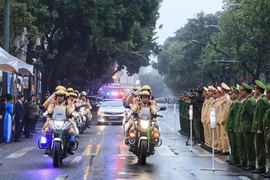
Hanoi (VNA) - The city of Hanoi has recently outlined the preliminary investment needs for research to complete the urban railway network, contributing to the reduction of current urban traffic congestion.
Urban railways offer a public transport system with significant transport capacity, safety, and environmental sustainability, addressing issues like congestion and accidents, while also fostering urban socioeconomic development.
Hanoi urban railway system commenced in 2007. The progress has been sluggish, failing to meet the growing transportation demands as urbanization accelerates.
With over 7.8 million road vehicles in Hanoi, including more than 6 million motorbikes, over 1 million cars, and an additional 1.2 million vehicles from neighboring areas, there is a clear imbalance among the various transportation modes.
This disparity has resulted in peak-hour congestion, increased transport costs, and environmental pollution issues.
According to the transportation development plan for Hanoi, the target is to achieve a public passenger transportation market share of 50-55% in the central urban area by 2030, and 65-70% post-2030.
However, current data from the Hanoi Department of Transport indicates that the city's public passenger transport handles approximately 19.5% of traffic, significantly below the planned targets.

The development of urban railways is seen as a key strategy to enhance public passenger transport, reduce reliance on personal vehicles, alleviate congestion, and drive socioeconomic growth in the city. This mode of transportation is modern, eco-friendly, and requires less land compared to other transport options.
The Urban Railway Project Management Board (MRB) stressed the importance of promptly completing investments in the urban railway system to bolster the city's transport infrastructure.
Once operational, the urban railway system is expected to transport around 3.2 million passengers daily, accounting for 35-40% of the public passenger transport market share in the central urban areas and approximately 20% in suburban areas.
An investment of over 55.4 billion USD is anticipated for the construction of the urban railway network.
Accordingly, MRB has proposed a preliminary research investment requirement of about 55.4 billion USD to prioritize the construction of urban railway lines.
The plan includes commencing construction of Line No. 2, Nam Thang Long - Tran Hung Dao section, by 2025.

By 2030, urban railways are anticipated to cater to 7-8% of passenger traffic, facilitating 2.2-2.6 million trips daily.
By 2035, the plan aims to complete the construction of 301km of urban railway, with an estimated investment totaling around 21 billion USD.
Post-2030, urban railways are anticipated to account for 35-40% of public passenger transport, facilitating 9.7-11.8 million trips daily.
Looking ahead to 2045, the goal is to complete the construction of 196.2km of urban railway, with a preliminary total investment of about 18.3 billion USD.
The funding structure is established based on the principle that the sections currently being developed with ODA loans will continue to be financed with ODA loans. The remaining sections will be prioritized for funding through the state budget./.



















